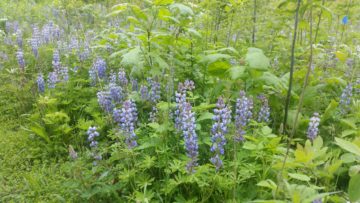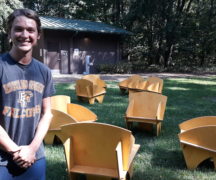By JAN LARSON McLAUGHLIN
BG Independent News
The Bordner Meadow in Wintergarden Park is putting on a show right now with no admission fee charged.
The periwinkle lupines have taken over sections, giving bursts of color to the meadow. But the show will only be in town for a few more days, when the lupine blooming season comes to an end.
“They are quite prolific,” Cinda Stutzman, natural resources specialist with the Bowling Green Parks and Recreation Department, said about the colorful meadow.
“It does put on a very nice show in the month of May,” Stutzman said.
People come out to the park just to take in the meadow mosaic of the floral spikes.
But the lupines haven’t always had a prominent place in the park. There was a time about 20 years ago when no lupines were left in the Bowling Green area. The flower that was once a signature plant in the Oak Openings area had nearly disappeared from the region.
“It was a potentially threatened plant in Ohio,” Stutzman said.
Lupines are pretty particular about where they take root.
“It’s picky in that it likes sand and sun,” Stutzman explained.
That combination made the Bordner Meadow a perfect home for the lupines since the area has sand ridges left after glaciers receded from the area.
So 17 or 18 years ago, the lupines were reintroduced to the meadow as part of a Bowling Green State University project. A total of 500 lupines were transplanted to the park.

Lupines
The lupines took over from there.
“From there it hasn’t taken much for the plants to spread,” Stutzman said. “It has a mind of its own.”
The masses of lupines have the bees busy pollinating the area. And the lupines have populated more of the meadow each year.
“They can hack the poor soil,” Stutzman said.
Reintroducing the lupines goes right along with the Bowling Green Park and Recreation Department’s purpose. “We are in the preservation business,” she said.
“It’s amazing how 500 transplants in the middle of the park have turned into this,” Stutzman said, looking over the meadow of lupines.
When the BGSU project was looking for lupines to transplant, the coordinators had to get seeds from Lucas County and Michigan.
“There were only a handful of plants left in the county,” Stutzman said.
When first settled, 80 percent of Wood County was swamp, and the other 20 percent was wet prairie, tall grass prairie, sandy dry prairie, oak woodland and oak savannah.
Bowling Green was “one of the few relatively dry places of the county.”
For those who miss the lupine show, another feature will be soon to follow.
“This is just the beginning,” Stutzman said of the lupines making their debut in May. Next comes the Prickly Pea Cactus in June – which was once a potentially threatened plant. “That’s always a favorite of a lot of people.”
Then in July come lots of sunflowers and three different spears of Blazing Stars. Then in August and September, the grasses take over the park show. And in the fall, the leaves are full of color.
“There’s something to enjoy in all the seasons,” Stutzman said.
And for those Wintergarden Park visitors who worry about the park staff mowing the meadow, Stutzman said the mowing serves a purpose. “There’s a method to the madness,” she said.
The mowing tries to do the job that fires and buffalo used to do, of decreasing certain plant populations.
“We’re trying to put things back into balance,” Stutzman said.





